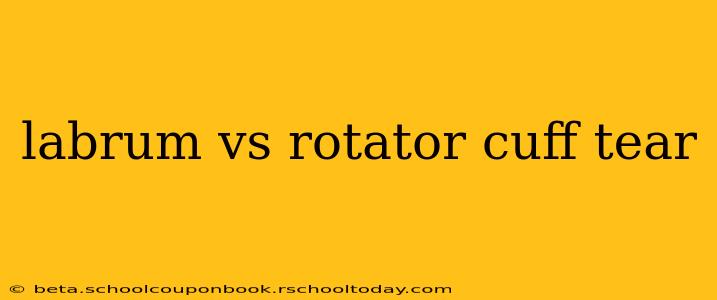Shoulder pain is a common complaint, often stemming from injuries to the labrum or rotator cuff. While both structures are crucial for shoulder stability and function, they are distinct and their injuries present differently. This article will clarify the key differences between a labrum tear and a rotator cuff tear, helping you understand the potential causes, symptoms, diagnosis, and treatment options.
What is a Labrum Tear?
The labrum is a ring of cartilage that surrounds the glenoid, the socket of the shoulder joint. It deepens the socket, enhancing stability and providing a seal for the joint. A labrum tear occurs when this cartilage is damaged, often due to a sudden injury or repetitive overuse. This can lead to instability, pain, and clicking in the shoulder.
Types of Labrum Tears:
- SLAP Lesion: Superior labrum anterior to posterior (SLAP) lesions are a specific type of labrum tear affecting the upper part of the labrum. They often involve the biceps tendon attachment.
- Bankart Lesion: These tears occur in the anterior (front) part of the labrum and are frequently associated with shoulder dislocations.
What is a Rotator Cuff Tear?
The rotator cuff is a group of four muscles and their tendons that surround the shoulder joint. These muscles (supraspinatus, infraspinatus, teres minor, and subscapularis) help with shoulder rotation, abduction (lifting the arm away from the body), and stability. A rotator cuff tear occurs when one or more of these tendons are torn, usually due to trauma or degeneration.
Types of Rotator Cuff Tears:
- Partial Tear: Only a portion of the tendon is torn.
- Full-Thickness Tear: The tendon is completely torn.
- Small vs. Large Tear: The size of the tear significantly impacts symptoms and treatment.
What are the Symptoms of a Labrum Tear?
Symptoms of a labrum tear can vary, but commonly include:
- Shoulder pain: This can range from mild to severe, depending on the severity of the tear.
- Clicking or popping: A distinct sound or sensation may be felt in the shoulder joint.
- Instability: Feeling like the shoulder is going to "pop out" or give way.
- Limited range of motion: Difficulty performing certain movements, such as reaching overhead.
- Weakness: Reduced strength in the shoulder.
What are the Symptoms of a Rotator Cuff Tear?
Symptoms of a rotator cuff tear are often:
- Shoulder pain: Pain can be constant or intermittent, often worse at night.
- Weakness: Difficulty lifting or rotating the arm.
- Limited range of motion: Restricted ability to raise the arm or reach behind the back.
- Catching or grinding: A sensation of the shoulder joint catching or grinding during movement.
- Swelling: In some cases, swelling may be present.
How are Labrum and Rotator Cuff Tears Diagnosed?
Diagnosis typically involves:
- Physical Examination: The doctor will assess your range of motion, strength, and stability.
- Imaging Tests: X-rays may rule out fractures, while MRI scans provide detailed images of soft tissues like the labrum and rotator cuff, offering a definitive diagnosis.
How are Labrum and Rotator Cuff Tears Treated?
Treatment options for both conditions can range from conservative to surgical approaches, depending on the severity of the injury and the individual's symptoms.
- Conservative Treatment: This may include rest, ice, physical therapy, medication (pain relievers and anti-inflammatories), and injections (e.g., corticosteroids).
- Surgical Treatment: Arthroscopic surgery is often used to repair both labrum and rotator cuff tears, minimizing invasiveness. Open surgery may be necessary in some cases.
What is the recovery time for a labrum tear vs. a rotator cuff tear?
Recovery time varies depending on the severity of the injury, the type of treatment received, and the individual's healing process. Conservative treatments might take several weeks to months for improvement, whereas surgical repair could take months for a full return to activity. Physical therapy is crucial in both scenarios for regaining strength and mobility.
Can you have both a labrum tear and a rotator cuff tear at the same time?
Yes, it's possible to have both a labrum tear and a rotator cuff tear simultaneously. The same trauma or repetitive stress can often affect multiple structures in the shoulder. A thorough diagnosis is crucial to determine the extent of the injuries and develop an appropriate treatment plan.
How are labrum and rotator cuff tears prevented?
Prevention strategies focus on:
- Proper warm-up and cool-down: Before and after any physical activity.
- Maintaining good posture: Avoid slouching or straining your shoulder muscles.
- Strengthening shoulder muscles: Regular exercise, particularly focusing on rotator cuff muscles.
- Proper lifting techniques: Avoid lifting heavy objects incorrectly.
This information is intended for educational purposes only and does not constitute medical advice. Always consult with a healthcare professional for accurate diagnosis and personalized treatment recommendations.
